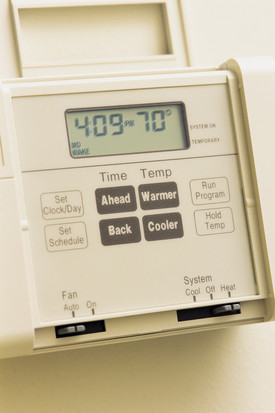In a forced-air system, fuel burned in the furnace releases heat energy to air circulating through it. The hot air is then blown by a fan that is timed to cycle on and off with the furnace. Timing of the fan is critical to the efficiency of the furnace, since it prevents the heat from backing up into the unit or from blowing cold air into rooms once the furnace has stopped. While dual-stage and variable-speed furnaces are available with blowers set at high-low or continuous settings, most furnaces are still single stage, gearing up with the blast of hot air so common to American homes.
Heat Distribution
 |
||||
|
||||
In a hot-air system, warm air is distributed via a main duct or "trunk" and a series of branches that lead to individual rooms or zones. Where the branches meet the trunk, heat is controlled by dampers which open or close to release or block heat from entry. These dampers are usually motorized and run by thermostatic controls at each zone. Individual registers may also be closed to block heat, but this is a less efficient use of the energy and heat produced than thermostatic or automatic controls.
Sizing the Furnace
Wherever there is heat production and control, there must be proper sizing of the heating element. More often than not, the answer to a cold house is not a larger furnace, but better distribution and control. Homeowners frequently opt for a larger furnace only to find that it is like keeping a bull in a playpen: too much energy produced without adequate outlet. Ensuing heat backup causes undue wear on the furnace, cracking, clogging or even noxious fumes and byproducts entering the home. So, take the time to properly size the furnace, the ducts and the outlets to be sure that you are using your furnace safely and efficiently.
Supply and Return: A Balancing Act
With a forced-air heating system, the supply must equal the return; the output must equal the input. While the ideal system would have one air return and one air supply register in each room, it is more common to find one return in each heating area or zone. The problem is that the furnace will suck against the house to find the air to fuel it. If there is not a ready supply of return air, this sucking effect will cause negative pressure in the house and dangerous backup of noxious fumes from the system. From a comfort perspective, if there is inadequate spacing of return vents, air will race to the furnace through rooms and down stairways, creating a draft and defeating any warm air delivery that was purchased at this expense.
Fortunately, return air runs are easy to create since they do not need to be housed in metal like supply runs. They can be cut in as floor registers feeding into staircase cavities, through stacked closets that run one on top of the other down to the basement, or in stud cavities in the wall. Where one return duct serves an entire zone, air space should be provided under doors so that when they are closed the registers can still draw air without pulling against the furnace.
Credit: Renovate Your World




























